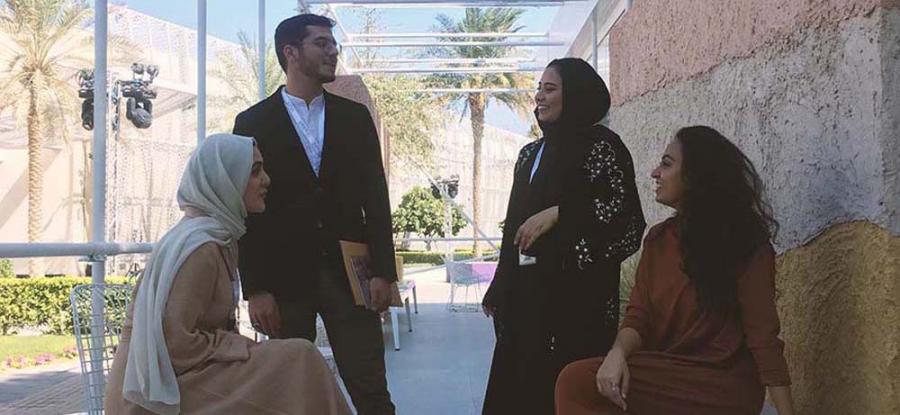- About
- Admissions
- Study at AUS
- Prospective Students
- Bachelor's Degrees
- Master's Degrees
- Doctoral Degrees
- Admission Publications
- International Students
- Contact Admissions
- Grants and Scholarships
- Sponsorship Liaison Services
- Testing Center
- New Undergraduate Student Guide
- Undergraduate Orientation
- New Graduate Student Guide
- Graduate Orientation
- File Completion
- Payment Guide
- Students with Disabilities
- Executive and Continuing Education
- Academics
- Life at AUS
- Research
- Publications
- Contact Us
- Apply Now
- .

Abu Dhabi Art Pavilion Prize 2018 awarded to AUS architecture students
Sharjah, UAE. December 4, 2018—Students and graduates from the College of Architecture, Art and Design (CAAD) at American University of Sharjah (AUS) took first and second place once again in the 2018 Abu Dhabi Art Pavilion Prize, the capital’s premiere art fair, which celebrated its 10th anniversary in November.
Abu Dhabi Art launched the Pavilion Prize initiative in 2017, with the winning submission also created by AUS students of architecture. The initiative invites university students from across the UAE to develop architectural proposals for temporary structures—or pavilions— to be built on site at Manarat Al Saadiyat as an informal space of gathering for artists, galleries and collectors during the fair.
This year’s first prize was awarded to AUS architecture students Jumanah Rizk and Laian Abussaud for their submission “Hawa” (the Arabic word for light wind), which was inspired by the winds of the sea from the northwest— also known as the Shamal wind.
Jumanah Rizk is a senior architecture student based in Dubai. Her interest in sustainability, environmental ethics, and social behavior leads her multidisciplinary approach to architecture and design. Guided by an interest in cultivating meditative spaces for heightened human interaction, her work encourages a cultural shift towards environmental considerations.
Rizk collaborated with Laian Zuhair, a Saudi Arabian national with a multicultural background. Zuhair is currently pursuing a Bachelor of Architecture degree and is passionate about digital fabrication, sustainable architecture and exploring how design can help improve the lives of others.
Under the guidance of Patrick Rhodes, Assistant Professor of Architecture, the two students created an experience of the UAE’s natural environment by creating a micro-ecosystem that fosters wind and sunlight to create a comfortable space with respect to vegetation.
“Our pavilion was heavily influenced by the late Sheikh Zayed bin Sultan Al Nahyan, Founder of the UAE, and his commitment to sustainability and preservation, with the design embracing the natural elements of air, sunlight and plant life,” said Rizk.
“We focused on the constructive nature of the UAE, translating this into an experiential space created from repurposed construction materials and scaffolding for the lightweight structure. And drawing from the vegetation clusters that disturb the regularity of the UAE landscape, we were able to represent the contrast between the natural and built conditions of the UAE,” said Rizk.
The pavilion contained three walls of rammed adobe, a natural and sustainable material that acts as both an obstruction to channel the wind as well as a thermal mass to effectively absorb heat. The light wells and vegetation pockets then acted as heat sinks, diffusing hot air away from the spaces.
Second prize was awarded to AUS architecture graduates Raghad Al Ali, Mohamed Abualhuda and Mohamed Rowizak under the guidance of Professor George Katodrytis, Head of the Department of Architecture at CAAD.
The trio forms MRM, a collaboration of passionate interdisciplinary architects who explore crossovers between art and architecture. Their work has received multiple national awards, including the Huda and Mohamed Kanoo Award in 2017, as well as recognition for their shortlisted entry to the Christo and Jeanne-Claude Award.
MRM described their entry into this year’s Abu Dhabi Art award: “In remembrance of Sheikh Zayed Al Nahyan, the Founding Father of the UAE, the pavilion evokes a mirage, fusing essences of transparency and serenity, while symbolizing an experience of the Sheikh’s vision — finding ‘prosperity, tolerance and peace.’”
“The pavilion conceals yet exposes an internal garden, surrounded by a series of modules that elevate to engulf the visitor, creating intimate-sublime pathways that gave a sense of closure but bring about a serene light quality to the space,” MRM explained.
The plan of the pavilion illustrates a field of hexagonal modules grouped into clusters where a path of trees renders a natural effect to the central space of the pavilion. The modularity of the design allowed for flexibility in the formal and structural systems of the pavilion, formed using a light-weight modular system that incorporates a structural perimeter. The material palette of the pavilion considered sustainability measures, and included polycarbonate panels, recycled rubber tiles, exterior-grade fabric, aluminum extrusions and vegetation.
“We are delighted to see both current and past AUS students awarded for their own unique contributions to the UAE’s cultural and architectural landscape. At CAAD, excellence, innovation and discipline are the keys to our students’ success, and we foster these qualities from the first day of Foundation studies through to graduation,” Professor Katodrytis said.
For more information about the College of Architecture, Art and Design and to see more examples of student work, visit www.aus.eda/caad.
ENDS

